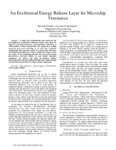Filters: Format: "application/pdf" School Or College: "College of Engineering" Collection: "ir_uspace"
| Creator | Title | Description | Subject | Date | ||
|---|---|---|---|---|---|---|
| 201 |
 |
Stevens, Kenneth; Myers, Chris J. | An asynchronous instruction length decoder | This paper describes an investigation of potential advantages and pitfalls of applying an asynchronous design methodology to an advanced microprocessor architecture. A prototype complex instruction set length decoding and steering unit was implemented using self-timed circuits. [The Revolving Async... | 2001 | |
| 202 |
 |
Bruderlin, Beat | An axiomatic approach for solving geometric problems symbolically | This paper describes a new approach for solving geometric constraint problems and problems in geometry theorem proving. We developed a rewrite-rule mechanism operating on geometric predicates. Termination and completeness of the problem solving algorithm can be obtained through well foundedness and ... | Geometric constraint problems; Geometry theorem proving; Knuth-Bendix completion algorithm | 1990 |
| 203 |
 |
Simpson, Jamesina J. | An E-J collocated 3-D FDTD model of electromagnetic wave propagation in magnetized cold plasma | A new three-dimensional finite-difference time-domain (FDTD) numerical model is proposed herein to simulate electromagnetic wave propagation in an anisotropic magnetized cold plasma medium. Plasma effects contributed by electrons, positive, and negative ions are considered in this model. The current... | 2010-01-01 | |
| 204 |
 |
Mathews, V. John | An efficient algorithm for joint estimation of differential time delays and frequency offsets | ABSTRACT This paper introduces an efficient algorithm that jointly estimates differential time delays and frequency offsets between two signals. The approach is a two-step procedure. First, the differential frequency offsets are estimated from measurement of the autocorrelation functions of the rec... | 1992 | |
| 205 |
 |
Mathews, V. John | An efficient algorithm for lattice filter/predictor | ABSTRACT An efficient method for updating the lattice filter/predictor coefficients using the sign algorithm is introduced. The pertinent coefficients are updated using only the signs of the estimation errors at each stage. This method requires less number of multiplications than other adaptive la... | 1985 | |
| 206 |
 |
Simpson, Jamesina J. | An efficient stochastic approach to uncertainty quantification in 3-D FDTD magnetized cold plasma | An efficient stochastic finite-difference time-domain (S-FDTD) method is developed to analyze electromagnetic field variability in three dimensional anisotropic magnetized plasma. The new S-FDTD plasma model provides a full understanding of the true physics due to the associated uncertainties and ha... | 2014-01-01 | |
| 207 |
 |
Sutherland, James Clayton; Kerstein, Alan R.; Chen, Jaqueline H. | An evaluation of the one-dimensional turbulence model: comparison with direct numerical simulation of CO/H2 jets with extinction and reignition | Abstract A variant of the One-Dimensional Turbulence (ODT) model formulated in an Eulerian reference frame is applied to a planar nonpre mixed turbulent jet flame and results from the model prediction are compared with DNS data. The model employed herein solves the full set of conservation equation... | 2010 | |
| 208 |
 |
Mastrangelo, Carlos H. | An exothermal energy release layer for microchip transience | A single layer nanothermite spin coated gel has been utilized as a solid-state exothermic energy release layer for triggered microchip transience. A proportional combination of self-assembled CuO/Al nanothermite and Napalm-B as gelling agent has been used to develop for the first time a spinable nan... | 2013-01-01 | |
| 209 |
 |
Willemsen, Peter; Gooch, Amy A. | An experimental comparison of perceived egocentric distance in real, image-based, and traditional virtual environment using direct walking tasks | In virtual environments, perceived egocentric distances are often underestimated when compared to the same distance judgments in the real world. The research presented in this paper explores two possible causes for this reduced distance perception in virtual environments: (1) real-time computer g... | Egocentric distances; Virtual environments | 2002-02-12 |
| 210 |
 |
Newman, William M. | An experimental display programming language for the PDP-10 computer | An experimental language for display programming, called DIAL, has been developed for the PDP-10 and the UNIVAC 1559 display. It is experimental in the sense that it was originally conceived as a means of testing out some ideas, and the best way to test them seemed to be to produce a language that ... | Display programming; DIAL; Display Algol | 1970 |
| 211 |
 |
Riesenfeld, Richard F.; Smith, Kent F. | An experimental system for computer aided geometric design | The main goal of this proposed level-of-effort project is to extend present capabilities in the area of Computer Aided Geometric Design (CAGD) and to develop custom VLSI support for some special geometric functions. | Computer aided geometric design; CAGD; VLSI; Very large scale integration | 1984 |
| 212 |
 |
Khoche, Ajay | An extended cell set of self-timed designs | The high level synthesis approach described in [1] uses hopCP[2] language for behavioral descriptions. The behavioral specifications are then translated into Hop Flow Graphs (HFGs). The actions in the graph are then refined such that refined actions can be directly mapped onto asynchronous circuit b... | Self-timed designs; hopCP; Hop Flow Graphs; Asynchronous circuit blocks; Action-blocks | 1993 |
| 213 |
 |
Myers, Chris J. | An improvement in partial order reduction using behavioral analysis | Efficacy of partial order reduction in reducing state space relies on adequate extraction of the independence relation among possible behaviors. However, traditional approaches by statically analyzing system model structures are often not able to reveal enough independence for reduction. To address ... | 2012-01-01 | |
| 214 |
 |
Gopalakrishnan, Ganesh; Humphrey, Alan Parker; Derrick, Christopher Glade | An integration of dynamic MPI formal verification within eclipse PTP | Our research goals were to verify practical MPI programs for deadlocks, resource leaks, and assertion violations at the push of a button and be able to easily visualize the results. We also sought to integrate these capabilities with the Eclipse IDE via an Eclipse plug-in for the Parallel Tools Plat... | Verification; Graphical User Interfaces; Dynamic Interleaving Reduction; Message Passing; MPI; Multi-core; Eclipse Parallel Tools Platform; Trapeze Interactive Poster | 2010-03-15 |
| 215 |
 |
Bruderlin, Beat | An interactive N-Dimensional constraint system | In this paper, we present a graph-based approach to geometric constraint solving. Geometric primitives (points, lines, circles, planes, etc.) possess intrinsic degrees of freedom in their embedding space. Constraints reduce the degrees of freedom of a set of objects. A constraint graph is created wi... | Geometric constraint solving | 1994 |
| 216 |
 |
Gopalakrishnan, Ganesh | An interface aware guided search method for error-trace justification in large protocols | Many complex concurrent protocols that cannot be formally verified due to state explosion can often be formally verified by initially creating a collection of abstractions (overapproximations), and subsequently refining the overapproximated protocol in response to spurious counterexample traces. ... | Concurrent protocols; Verification; Error-trace justification | 2008 |
| 217 |
 |
Sikorski, Kris | An interior ellipsoid algorithm for fixed points | We consider the problem of approximating fixed points of non-smooth contractive functions with using of the absolute error criterion. In [12] we proved that the upper bound on the number of function evaluations to compute ?-approximations is 0(n3(In 1/? + In 1/1-q +In n)) in the worst case, where ... | Ellipsoid algorithm; Contractive functions; Fixed points | 1998 |
| 218 |
 |
Davis, Al | An introduction to asynchronous circuit design | The purpose of this monograph is to provide both an introduction to field of asynchronous digital circuit design and an overview of the practical state of the art in 1997. In the early days of digital circuit design, little distinction was made between synchronous and asynchronous circuits. However,... | Asynchronous circuit design | 1997 |
| 219 |
 |
Riloff, Ellen M. | An introduction to the Sundance and AutoSlog systems | This document describes the Sundance natural language processing system that has been developed at the University of Utah, as well as the AutoSlog and AutoSlog-TS extraction pattern learners that have been implemented on top of Sundance. Sundance is a shallow parser that also includes clause hand... | Sundance system; AutoSlog system; Extraction pattern learners | 2004-11-08 |
| 220 |
 |
Regehr, John | An isotach implementation for myrinet | An isotach network provides strong guarantees about message delivery order. We show that an isotach network can be implemented efficiently entirely in software, using commercial o-the-shelf hardware. This report describes that effort. Parts of this implementation could be performed much more efficie... | 1997-01-01 | |
| 221 |
 |
Carter, John B. | An O(1) time complexity software barrier | As network latency rapidly approaches thousands of processor cycles and multiprocessors systems become larger and larger, the primary factor in determining a barrier algorithm?s performance is the number of serialized network latencies it requires. All existing barrier algorithms require at least ... | Network latency; Barrier algorithm; Time complexity software barrier | 2004 |
| 222 |
 |
Henderson, Thomas C. | An O(n) time discrete relaxation architecture for real-time processing of the consistent labeling problem | Discrete relaxation techniques have proven useful in solving a wide range of problems in digital signal and digital image processing, artificial intelligence, operations research, and machine vision. Much work has been devoted to finding efficient hardware architectures. This paper shows that a conv... | Discrete relaxation techniques | 1986 |
| 223 |
 |
Mathews, V. John | An optimal design procedure for intraband vector quantized subband coding | AbstTact- Subband coding with vector quantization is addressed in this paper. Forming the data vectors from both between and within the subbands is considered. The former of these two schemes is referred to as interband coding and the latter as intraband coding. Interband coder design is relatively ... | 1995 | |
| 224 |
 |
Gu, Jun | An optimal, parallel discrete relaxation algorithm and architecture (Revised January 1988 and August 1989) | A variety of problems in artificial intelligence, operations research, symbolic logic, pattern recognition and computer vision, and robot manipulation are special cases of the Consistent Labeling Problem (CLP). The Discrete Relaxation Algorithm (DRA) is an efficient computational technique to enfor... | Consistent Labeling Problem; CLP; Discrete Relaxation Algorithm; DRA | 1988 |
| 225 |
 |
Harrison, Reid R.; Myers, Chris J.; Schlegel, Christian | Analog decoding of product codes | A design approach is presented for soft-decision decoding of block product codes ("block turbo codes") using analog computation with MOS devices. Application of analog decoding to large code sizes is also considered with the introduction of serial analog interfaces and pipeline schedules. | 2001-01-11 |
